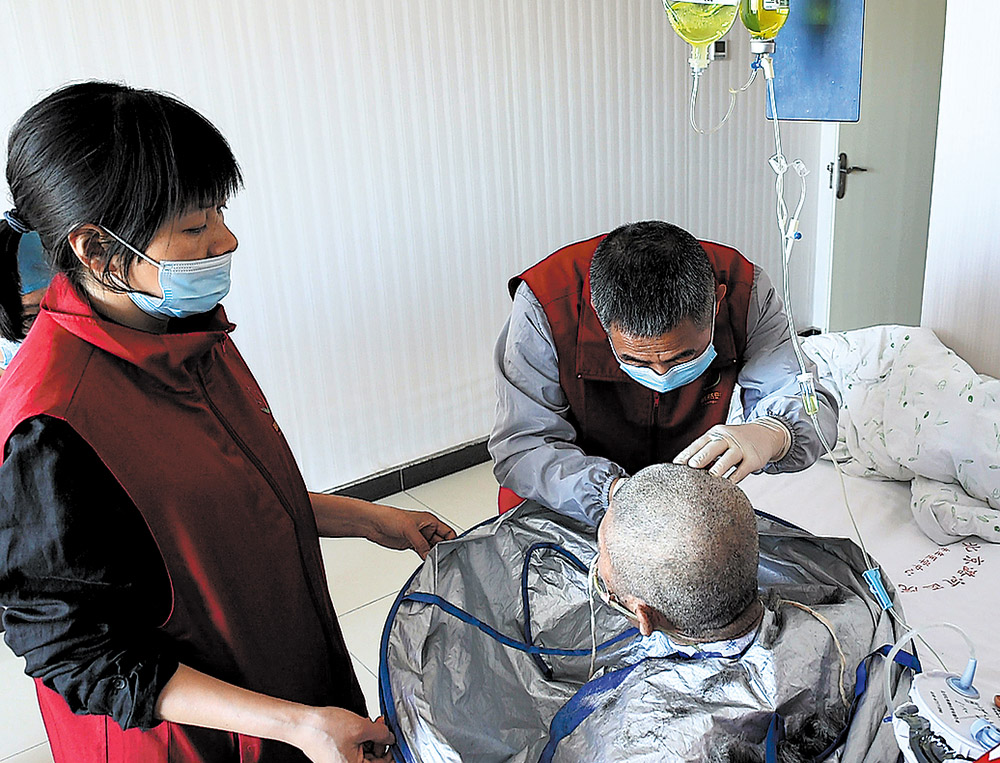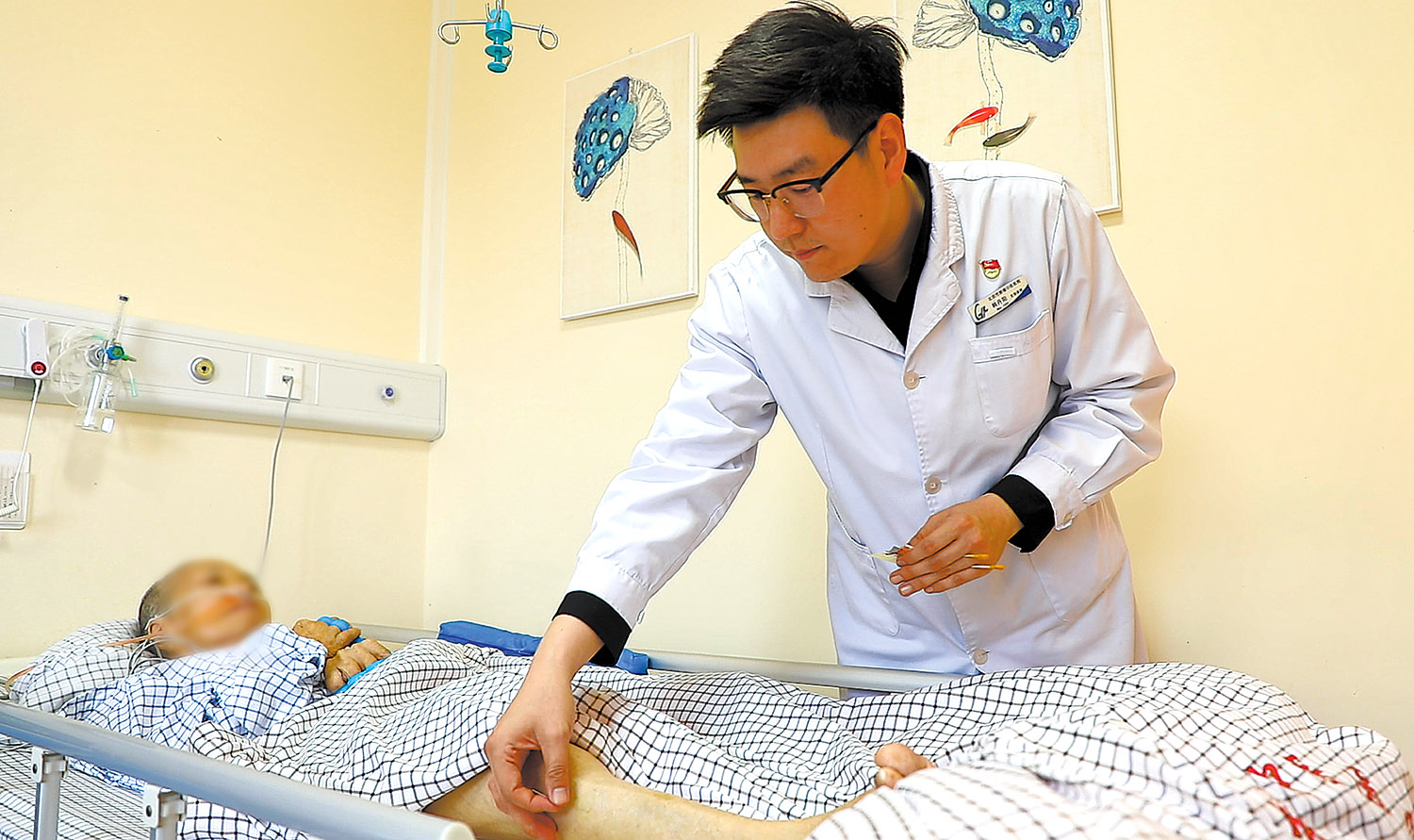As nation's population ages, cultural taboo of hospice care slowly lifted

On May 15, 2024, a family gathered at the palliative care ward of Gulou Hospital of Traditional Chinese Medicine in Beijing to take a cherished family photo. The moment was for 87-year-old Yang Nushi, who had suffered a stroke four years ago and had been admitted to the ward just days earlier.
The hospital staff, upon learning of Yang's lifelong love for Peking Opera, decorated her room with photos from her younger days, including images of her performing in elaborate costumes. They added a touch of spring, with blooming pink peach blossoms and lush greenery.
Yang's husband, Li Xiansheng, held a bouquet of pink flowers as he gazed tenderly into her eyes. The couple, both originally from Suzhou in Jiangsu province, shared a love spanning more than six decades. The two married in 1962.
READ MORE: Aging population forces rethink on family duties, healthcare
"We were classmates in high school and later attended Peking University together," Li said. "After graduation, we even worked at the same place."
Three of Yang's nieces traveled from Suzhou to participate in the photo session, creating a moment of shared gratitude and connection. Though her speech was labored, Yang expressed her thanks in her own way. The medical team, a social worker and a volunteer also joined in for the photos, marking a poignant moment of unity and care.
The family photo was one of many efforts to honor Yang's final chapter, supported by the medical professionals at the hospital's hospice care ward.

New approach
Gulou Hospital of Traditional Chinese Medicine is among Beijing's first pilot institutions offering hospice care.
"We integrate traditional Chinese medicine techniques, such as acupuncture, moxibustion, and cupping therapy, to alleviate pain and symptoms like abdominal bloating and constipation," explained Han Danyang, director of oncology at the hospital.
"Our multidisciplinary approach aims to help patients feel comfortable, peaceful and dignified in their final days," Han said.
The palliative care ward provides holistic support for terminally ill patients and their families, addressing medical, physical, psychological, social and spiritual needs.
"The goal is to help people facing the end of life to do so with comfort, peace and dignity," Han added.
Hospice care emphasizes quality of life and dignity. It operates on the philosophy that death is a natural part of life and that people should live fully and comfortably for as long as they can, surrounded by loved ones.
"We cannot control when life begins, but we can choose how we think about death," said Lu Guijun, director of the pain management department at Beijing Tsinghua Changgung Hospital.
With 27 years of experience in palliative care, Lu has witnessed countless unique and meaningful farewells. "Some patients held personal photography exhibitions, others hosted farewell dance parties. Some wanted to spend their final moments with their pets or chose specific music for their funerals. Others simply asked for one last sip of cola or coffee," Lu recounted.
For Lu, death is not a taboo. "Hospitals are places of healing, but they are also places of farewell. If we don't understand death, we cannot truly appreciate the boundaries of saving lives," he said.
Since launching its palliative care ward in 2019, Lu's hospital has cared for over 300 patients, most of whom were in the late stages of solid tumors. The average survival time in the ward is about one month.
"People at the end of life need more than just medication. They need a life that is calm, authentic and filled with love," Lu emphasized. "Relieving physical pain is the foundation of palliative care, but it is equally important to ease the emotional suffering of patients and their families."
Palliative care, Lu noted, is about respecting the wishes of patients and their families while minimizing pain and maximizing comfort.

Challenges and promises
The hospice care movement traces its origins to Cicely Saunders, who founded St. Christopher's Hospice in the United Kingdom in 1967. It emerged in response to the limitations of modern medical technology, which, while capable of extending life, often prolonged the suffering of terminally ill patients. Hospice care offered an alternative — prioritizing comfort and dignity over curative treatments.
China began to explore the concept of hospice care in the late 1980s. In 1988, Tianjin Medical College established the country's first hospice care research center. However, progress remained minimal until the last decade. In 2016, hospice care was included in a national health policy document for the first time. The following year, the National Health Commission issued guidelines for its implementation, spurring rapid growth. The number of medical institutions with hospice care departments expanded from 276 in 2018 to 4,259 by the end of 2022.
Despite these strides, the need for palliative care far outweighs its availability. According to a 2024 report by the Ministry of Civil Affairs, China officially entered the "deep aging" stage in 2023, with over 14 percent of its population aged 65 and above. By 2035, the country is projected to become a super-aged society.
China faces further hurdles in medication access. Of the country's 1 million registered medical institutions, only about 36,000 are authorized to prescribe painkillers, and fewer than 18,000 have intravenous pain medications. Fewer than 5,000 institutions nationwide have dedicated palliative care departments. These limitations severely constrain the development of home-based palliative care, which forms the backbone of services in countries like the United States, Japan, and Australia, where over 70 percent of palliative care is delivered at home.
"Palliative care is not about giving up on patients; it's about balancing the length and quality of life," said Chen Yan, a physician in the Palliative Care Department at Fuzhou First Hospital. "It's about focusing on the patient — considering their wishes and addressing their needs."
Fuzhou First Hospital's Palliative Care Department is the only one of its kind in a tertiary hospital in Fujian province. The multidisciplinary team includes doctors, nurses, social workers, volunteers and nutritionists. They offer therapies such as aromatherapy, music therapy, and lymphatic care to provide patients with comprehensive support.
Yet even as the number of hospice facilities increases, the gap between need and availability remains vast. According to Lu Guijun of Beijing Tsinghua Changgung Hospital, more than 10 million people die annually in China, with approximately 3 million deaths from cancer. "Two-thirds of these individuals require palliative care services, but the actual coverage rate is extremely low," Lu said.
Although precise statistics are unavailable, industry experts estimate that less than 10 percent of terminally ill patients in China access palliative care each year. Even those fortunate enough to access such services often face significant hurdles, including long waitlists and limited resources.

Overwhelmed system
At Beijing Tsinghua Changgung Hospital, the palliative care ward consists of just eight beds: four single rooms and two double rooms, the latter often used for day patients requiring short-term pain management. The limited capacity underscores the severe shortage of hospice care services across the country.
Traditional beliefs also play a role. Many Chinese families prioritize prolonging life at any cost, reflecting the sentiment captured in the saying: "It's better to live a wretched existence than to experience a good death."
This cultural mindset often leads to aggressive medical interventions, even in the face of terminal diagnoses.
"Pain can range from mild to severe," explained Li Zhigang, an attending physician in the Pain Management Department at Beijing Tsinghua Changgung Hospital. "Severe pain usually requires advanced treatments, such as spinal cord stimulation, nerve blocks, or intrathecal pain pump implantation."
Cancer-related pain is a significant challenge. In 2022, China reported 4.8 million new cancer cases, the highest number in the world. Among late-stage cancer patients, 60 to 80 percent experience pain, with one-third suffering from severe symptoms.
"Late-stage cancer patients often have complex needs. Beyond pain, they may experience shortness of breath, nausea, bowel obstruction, or edema," said Li Yaling, head nurse of the hospital's palliative care ward.
"Only with specialized care can we provide the comfort these patients deserve."
A path forward
As China grapples with an aging population and a rising demand for end-of-life care, the country must continue to expand hospice services while addressing systemic and cultural barriers.
Han Qide, an academician of the Chinese Academy of Sciences, has long championed the development of palliative care in China. He identifies a significant cognitive barrier: the prevailing mindset that insists, "Even with a one-in-ten-thousand chance, we must try to save the patient in the ICU."
Gao Huatian, a professor at Sichuan University's West China Hospital, highlighted a common scenario: terminally ill patients sent to ICUs, their bodies connected to tubes and machines in a desperate bid to prolong life. While intended to fulfill filial duties or uphold a doctor's mission, such measures often cause immense suffering.
Globally, 136 countries and regions have established palliative care institutions, with 20 incorporating palliative care into their social health insurance systems. Foundational and continuing medical education, as well as team development, have steadily advanced in these nations.
In recent years, China has shown increasing support for palliative care. The Healthy China 2030 blueprint promotes integrated health and eldercare services, including inpatient treatment, rehabilitation, daily living assistance, and palliative care. In 2020, palliative care was formally included in the Basic Healthcare and Health Promotion Law.
ALSO READ: Dying with dignity, living with love
In 2022, Shenzhen became the first city in China to pass legislation allowing terminally ill patients to decline excessive lifesaving treatments, safeguarding their right to a dignified death. The city's revised medical regulation stipulates that medical agencies must respect a patient's living will regarding traumatic rescues, life-supporting machines, or primary disease treatments at the end of life.
For some, the journey into hospice care begins with small, personal steps. Zhang Xuemei first encountered the concept of hospice care during a charity walk in 2019. Inspired, the then-thirtysomething volunteered at institutions providing end-of-life services.
By 2021, Zhang had become a full-time social worker at a hospice ward in Beijing's Tongzhou district affiliated with Luhe Hospital. Her day begins with morning meetings, where doctors and nurses exchange updates on patients and plan their care. Zhang has built close relationships with each patient in the ward.
"We're here to help patients live as well as possible until they die — and to ensure they die with dignity," Zhang said.
Contact the writers at caihong@chinadaily.com.cn


